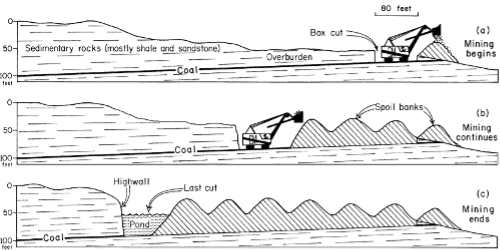MINING IN OKLAHOMA
Coal mining started in Oklahoma in 1872, taking place primarily in a 16-county area on the eastern side of the state. Early production came almost entirely from underground mines, but with the development of larger power equipment, surface mining became the preferred approach and continues to be the primary mining method used in the state. Over 32,000 acres of land have been used for surface mining and another 40,000 acres have been used for underground mining, resulting in many abandoned mining sites that threaten the environment as well as Oklahomans’ health and safety.

Schematic showing underground room-and-pillar mining

Schematic cross-sections showing stages of surface mining for coal. Oklahoma Geological Survey.
CONSERVATION CONCERNS
For years, conservation district directors in eastern Oklahoma voiced their concerns about these unclaimed mined areas and spoke to local lawmakers about legislation to address the issue. This advocacy led to the passage of the Open Cut Land Reclamation Act in 1968, which required leveling only the tops of spoil ridges to a width of 10 feet, a requirement that many deemed inadequate. In 1971 these reclamation guidelines were strengthened to require “a rolling topography traversable by machines or equipment commonly used with the land after reclamation.” Still dissatisfied by this requirement, conservation district directors and other environmental advocates turned to Congress for assistance in passing more robust mine reclamation legislation.
FEDERAL LEGISLATION
On August 3, 1977, President Jimmy Carter signed Public Law 95-87, known as the Surface Mining Control and Reclamation Act of 1977. This legislation created a national system for controlling the surface effects of active coal mining and established a trust fund dedicated to reclaiming hazardous orphan coal mine land. The trust is funded by fees on active coal mining.
Within months of Public Law 95-87 passing, Governor David Boren designated the Oklahoma Conservation Commission as the state agency responsible for reclaiming abandoned coal mine land in Oklahoma. On May 19, 1981, Governor George Nigh signed Senate Bill 217 implementing the Abandoned Mine Land (AML) Program in Oklahoma, which was subsequently approved by Cecil Andrus, the Secretary of the U.S. Department of the Interior at the time. Oklahoma is one of the few states where conservation districts are actively involved with AML reclamation efforts.